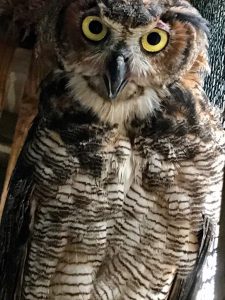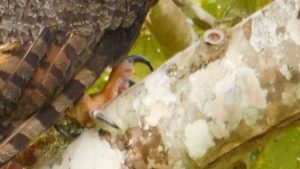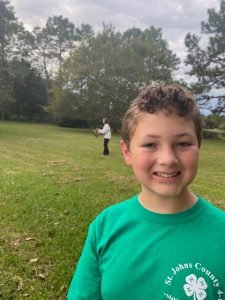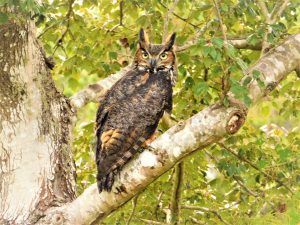Big Enough to Be on His Own

Eight months after Bucky’s rescue by a 4-H youth, he was ready to be on his own. He had successfully learned how to hunt and feed himself. Adult great horned owls mature to a height of between 18-25 inches. Adult female owls weigh approximately 3.45 pounds, while males weigh approximately 2.69 pounds. Once Bucky reached his mature height of 22 inches and weighed 3 pounds, it was time for his release.

The Great Horned Owls are named as such because of the feather tufts on the top of their head. Their faces have short feathers that funnel sound to their ears. Birds, except vultures, lack a sense of smell making hearing the key to their hunting ability. Their 3D hearing can locate prey just from sound. They will eat almost anything; mice, rats, rabbits, and other rodents are their main meals. Great horned owls will also attack other birds, snakes, and even skunks. In the wild, they are the top nighttime predator. They have extremely strong talons and bill which allow them to catch and consume their prey.
Ready to Fly

H.A.W.K.E.‘s (hawkewildlife.org) director, Melanie Cain-Stage, wanted as many 4-H’ers as possible to see this extraordinary event. She chose the Extension Office property for the release. There are several large pine trees, their favorite place to roost, around the pond and along the edge of the woods. The release was set for 6:00pm on a Sunday. I promoted the release to the 4-H families, encouraging them to come witness this special event. On Sunday, 20 4-H’ers and their families came to the release. When she pulled Bucky out of his cage, he flailed around appearing anxious to get into the trees.
Fly Away

Bucky never imprinted on humans and instead learned how to be an owl from an adult great horned owl. Melanie warned everyone that Bucky was mean and it could be dangerous to get too close. Because of the danger, Nathan and the other 4-H’ers stood a safe distance from the release. Even with the distance, Bucky was so large, it was easy to see the release unfold. However, it was difficult to get a clear photo of Bucky. Nathan was so excited to see how his quick thinking and love of wildlife led to this amazing release. Everyone held their breath as they waited for Bucky to fly. On the count of three, she spun around with Bucky to give him an extra push into the air. He flapped his large wings and flew through the trees. We lost sight of him as he flew to the back of the property.
Time for a Rest

We all wanted to know where Bucky landed so we walked to the other side of the pond where he’d last been seen flying. The fastest people got to a grove of trees and spotted him perched in the crook of a small tree. Bucky must have been tired because he sat very still on the branch. He didn’t seem bothered by all the people staring at him and taking photos. The group was more than 30 feet away. Bucky only moved his head to see what was happening around him. Owls don’t have peripheral vision because they have fixed eye sockets. To overcome this characteristic, they can turn their head 270 degrees around. Because they can turn their heads so far, they don’t have to move very much thus not attracting the attention of prey.
An Uninvited Guest
We heard a bird squawking close by. It didn’t take long for the mockingbird to come out and attack the owl. Mockingbirds are territorial. They will guard their nest from other mockingbirds and predators such as great horned owls. Mockingbirds have been known to harass people who they felt threatened by. They will also go after birds that try to take over their food source, especially in the winter. Birds such as the mockingbird will risk their lives to attack a solitary great horned owl that is close to their nest.
Eventually the mockingbird gave up. Once it got too dark to see the owl well, everyone headed home. My family went to a restaurant around the corner for dinner. After dinner, with Bucky on my mind, we went back to the tree we had last seen him in. We were pleased to find that he was gone.
The Next Day
I spoke with Melanie the following day and shared the story of going back to check on Bucky after dark. She said that he had sat for so long because he was waiting for nighttime to explore with his ears.
She explained what was next for Bucky. Great horned owls and other owls can survive in big cities or rural areas. They can live over 15 years in captivity. Bucky should do fine where he was released. He was extremely strong and a good weight. He has no problems to keep him from having the best chance of a great life.
 0
0

Comments:
April 22, 2022
Harvest day is tomorrow, April 23rd at 9am.
April 12, 2022
When is date and time of potatoes harvest? Thanks
October 29, 2021
Awesome!!!
September 13, 2021
Unfortunately our event was postponed until 2021 due to the lack of vendor participation, and overall health concerns for such as large event. Sorry for the sad news! We'll have the hot sauce contest next year for sure.
September 13, 2021
Will there be a hot sauce contest at the festival?
June 29, 2020
The program will still take place this year, however, the timeframe to apply for this year's program has passed. Please send me an e-mail next spring to get on next year's e-mail application list. Thanks! terraf@ufl.edu
June 28, 2020
Im interested. Is the program still open even with the covid situation?
January 30, 2020
https://extadmin.ifas.ufl.edu/cflag/ you should be able to find the flyer here sometime this summer. thanks,
January 29, 2020
Thank you Tim. Is there somewhere I can get on an email list for information?
January 9, 2020
Yes, this class is usually offered in August. I will post information as it becomes available.
January 9, 2020
will you be planning another one of these classes ?
August 21, 2019
For further information on herbs, please contact the master gardener desk in St. Johns County at 904-209-0430 x4782.
August 2, 2019
I am interested in learning to grow medicinal herbs
May 9, 2019
What age group is this for? What is the cost of the class? I didn't see the link to sign up for this class.
Comments are closed.